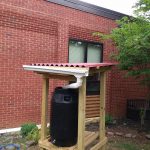School: The Newton School, Sterling, VA
First Grade Teacher: Ms. Lea Hodges
Project Title: Growing Food Indoors & Learning Self-Sufficiency
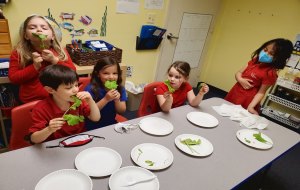 The Newton School students had an incredible year learning cross-curricular: researching, reading, brainstorming, planning, measuring, calculating, predicting, checking on growth and monitoring for detrimental bugs and sufficient watering, and carefully and mindfully tending to their growing beautiful indoor garden. The job as a gardener was part of the classroom jobs, but there were always multiple students who wanted to water, check out the growth, and eat some of the plants! The class was able to harvest a variety of root vegetables; radishes, carrots, and beets, along with a couple small bell peppers and shared them with multiple students and staff in the lower and middle school classes, all while sharing important nutritional and beneficial facts to gently persuade others to eat and grow food themselves. Through these specific harvested vegetables, they learned the benefits of using and eating all parts of the plant and what parts hold more nutrients than others, specifically the leaves retain a higher nutrient level than the typical eaten root portion of the plant.
The Newton School students had an incredible year learning cross-curricular: researching, reading, brainstorming, planning, measuring, calculating, predicting, checking on growth and monitoring for detrimental bugs and sufficient watering, and carefully and mindfully tending to their growing beautiful indoor garden. The job as a gardener was part of the classroom jobs, but there were always multiple students who wanted to water, check out the growth, and eat some of the plants! The class was able to harvest a variety of root vegetables; radishes, carrots, and beets, along with a couple small bell peppers and shared them with multiple students and staff in the lower and middle school classes, all while sharing important nutritional and beneficial facts to gently persuade others to eat and grow food themselves. Through these specific harvested vegetables, they learned the benefits of using and eating all parts of the plant and what parts hold more nutrients than others, specifically the leaves retain a higher nutrient level than the typical eaten root portion of the plant.
All parties that had an opportunity to be involved with this project were very excited, interested, engaged, and continue to grow their knowledge in eating these specific foods, understanding the importance of planting, and creating more paths of self-sufficiency and self-sustainability through small changes at home and in school. A couple of critical vocabulary words that we learned that was applied to each facet of the project was the importance of “planning” and “space”. Through all avenues of student exploration, we discovered why if we didn’t plan efficiently how it would affect our outcomes, and how space in growing, living, and being is just as important as the quality and amount of soil, water, light, and love/attention that is required for a living organism to successfully thrive in its environment. Listening to and watching the students present this information to kids of all ages and adults with clear and confident value and meaning was beyond very gratifying and the grant accomplished its job!
Thank you so much for this incredible, amazing, unforgettable opportunity and experience. These lessons, memories, and cherished moments will stay with us and help us grow to make this world a more fruitful, healthier, happier place.
School: Lovettsville Elementary, Lovettsville
Project Title: Lovettsville Elementary School Garden Rain Barrel System
Hugh Brockway and the staff and students at Lovettsville Elementary have been taking care of a thriving garden located on the school grounds, which was funded by Loudoun Soil and Water two years ago. The students and staff recognized a need to capture and conserve rain water for this amazing garden. The garden area is located where there are no down spouts and surrounded by flat roofing. To remedy this problem, Mr. Brockway and his students, along with fellow staff members, collaborated and designed a structure that collects rain water and funnels it into rain barrels. Students will be doing data assessments to determine the amount of water saved and collected as the project continues.
School: Blue Ridge Middle School, Purcellville
Project Title: Can we improve our schoolyard environment by creating an inviting habitat for tree swallows and blue birds?
The 285 sixth grade science students at Blue Ridge Middle School (BRMS) built, decorated and installed 30 bluebird and tree swallow nesting boxes. The nesting boxes are placed along the perimeter of BRMS, which is located in Purcellville, VA. Students observed nesting behaviors via a web cam binoculars and spotting scope as the birds feed their young.
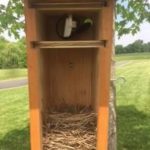 |
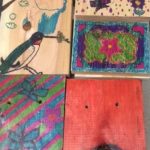 |
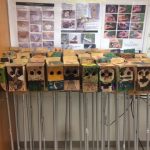 |
School: Park View High School, Sterling
Project Title: Multiculture, Vermiculture, Agriculture: An Organic & Eco-Friendly Learning Space
A report from the school….
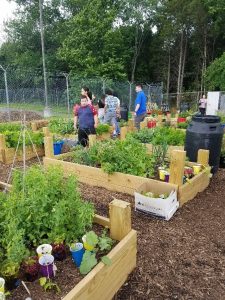 |
 |
This project has far exceeded our expectations for the first year! We received generous funding from numerous organizations, and skilled volunteers who taught us about nutrition and how to construct raised garden beds, plant crops, build a bee hotel, make straw bale planters, and set up worm bins. We have used three different hydroponic planting systems and a growing table for seedlings in the classroom, and four composters and four rain barrels outside for nutrients and irrigation. No pesticides or non-organic fertilizers have been used.
Besides our Special Needs program students, ELL newcomers, and Environmental Science students, even more of our Park View student population became involved in establishing the garden in response to our request for help with mulching, building, planting, and other chores. Our Self-Contained ID classes were involved from the beginning in composting and planting. Environmental Science students researched and reported on companion plants, straw bale planters, pH needs, soil testing, and vermiculture. They also began the hydroponic gardens in the classroom and started seedlings early for transplanting.
Student volunteers from the PEER club worked with our special needs students; US Government classes came out during SOL’s for community service; athletic teams and others in weight training came after school to shovel and spread mulch; and students in In-School Restriction spread mulch, and built and filled additional raised beds for our pollinators. Art and Marketing students did promo ads, posters, and tweets; they named our garden the “Patriot Patch.”
This summer, students in Camp REAL have come to thin, harvest, weed, and finish mulching the garden. Twenty 5th through 8th graders from our cluster schools participated, familiarizing them with the garden that they may later be working in as high schoolers!
Throughout it all, students learned not only about gardening, but transferable academic and life skills as well: planning, measuring, using tools, working together as teams, good nutrition, plant development and needs, cleaning and prepping vegetables for cooking and eating, composting, eco-friendly practices, etc.
Our garden consists of ten raised beds: seven planted with vegetables and herbs; one sensory bed with plants having unusual textures (lamb’s ear), sounds (sea oats), colors/shapes (purple basil, Siberian iris, day lilies, dracaena), scents (scented geraniums – lemon and citronella, chocolate mint, herbs), taste (strawberries, mint, basil, other herbs); and two beds with beautiful flowering nectar plants for the pollinators. We are on our second vegetable planting, having harvested greens (spinach, kale, lettuce, chard), peas, radishes, carrots, beets, and onions. Our second planting is growing several varieties of tomatoes, peppers, onions, and green beans, plus continued cultivation of herbs and strawberries. We also have seasoned and planted 10 straw bales along the fence with different vines: squash, cucumbers, gourds, and pumpkins, and have several large pots with flowers, large herbs, and blueberries.
We have given our harvested vegetables to our Gourmet Foods class for their end of semester dinner, to some of our students and their families, to school employees, and to our cafeteria. We have served fresh salads from the garden during our Monday “Lunch Bunch” and our ribbon cutting. We’re looking forward to lots of summer tomatoes and peppers, plus the straw bale vegetables in the fall.

